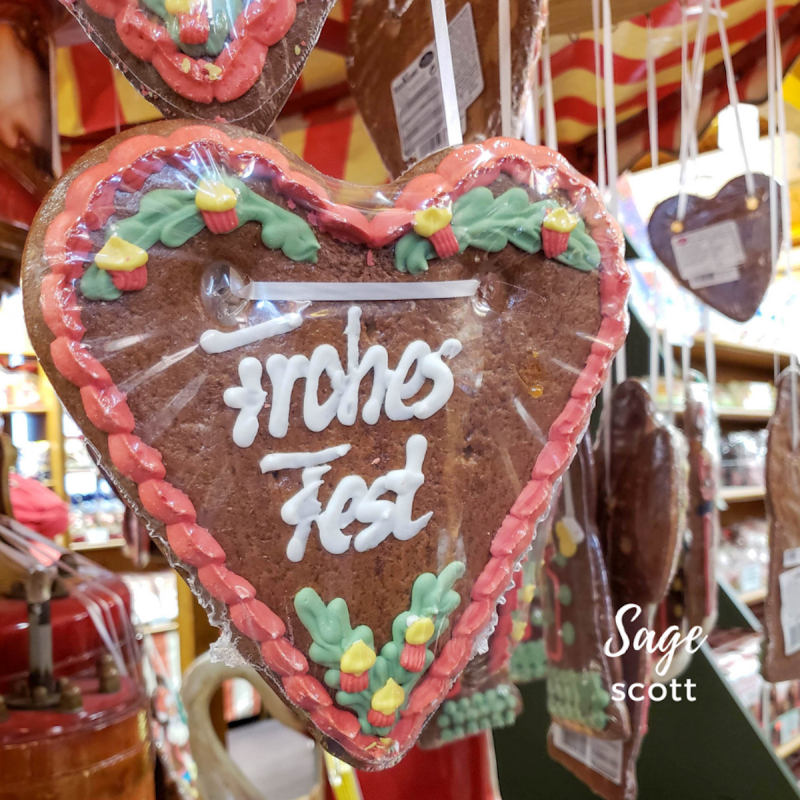
From beautifully decorated fir trees to festive nutcrackers, and from gumdrop-topped gingerbread houses to red-and-white-striped candy canes, we can thank the Alpine region of southern Germany for many of the Christmas traditions embraced throughout Europe and North America today. Although there is some debate over whether Germany or Austria gets bragging rights for creating the Christmas market, the festive open-air markets known as Weihnachtsmarkt or Christkindlmarkt have spread far and wide since they were first introduced in the Middle Ages.
Videos by TravelAwaits
Whether you are visiting the best Christmas markets in Germany or these Bavarian-style Christmas markets in the United States, these are the delicious German foods, desserts, and drinks you won’t want to miss!

1. Wurst
Although there are more than 1,500 types of wurst (sausages) in Germany, you won’t have to navigate your way through that long of a list at a German Christmas market. Served grilled in a brötchen (a hard German roll) and topped with senf (spicy German mustard), one of the most popular German sausages at a Christmas market is bratwurst. And if you are visiting a Christmas market in Bavaria, you’re likely to find weisswurst, a white sausage made of minced veal, bacon, and parsley that is a local specialty.

2. Currywurst
While most wurst are served in what I call “hot dog style,” inserted into a sliced roll, currywurst is cut into discs and covered with sweet curry ketchup and a dusting of curry powder.
Pro Tip: Enjoy delicious German foods any time of year with these Bavarian dishes.
3. Schnitzel
You are likely familiar with schnitzel, a thinly pounded pork cutlet that is breaded and pan-fried. But at German-style Christmas markets, this classic entrée is often sold on a stick or as a sandwich to make it a portable dish that keeps you on your feet and browsing vendor stalls.
Pro Tip: If you plan to enjoy Wiener schnitzel, named after Austria’s capital city, these are the best Christmas markets and holiday experiences in Vienna.

4. Kartoffelpuffer
Made from grated potatoes mixed with diced onion, egg, and spices, kartoffelpuffer are German potato pancakes that are pan-fried until a crispy golden brown. They’re often topped with a dollop of crème fraiche (similar to sour cream) or smothered in fresh applesauce.

5. Flammkuchen
Although it is originally from Alsace, a sliver of eastern France just across the Rhine River from Germany, this delicious German food is popular at Christmas markets. Resembling a flatbread pizza, flammkuchen is traditionally topped with crème fraiche, thinly sliced onions, and lardons (diced pork fat similar to diced bacon).
But just like pizza toppings have evolved over the years (pineapple, anyone?), so have flammkuchen flavors. So don’t be surprised if you find pesto, mozzarella, and tomato, prosciutto and arugula, and vegetarian and vegan flammkuchen options at a German Christmas market.
6. Brezel
Known as a pretzel in the English-speaking world, these doughy twists are as German as beer and bratwurst, so look for them at German-style Christmas markets across Europe and from coast to coast in the United States. While Americans might dip pretzel chunks into nacho cheese sauce, Germans are more likely to enjoy their brezel with senf or an onion-and-spice-filled soft cheese dip known as obatzda.
7. Knoblauchbrot
For a garlicky, carb-filled alternative to pretzels, try knoblauchbrot. While garlic bread may not sound that exotic (then again, neither do pretzels), the German version is typically pan-fried in butter or deep-fried and then covered in crème fraiche or sour cream.
8. Gebrannte Mandeln
These sugar-and-spice-roasted nuts are a staple at German Christmas markets, whether you’re celebrating the holidays in Europe or stateside. Traditionally made by caramelizing almonds in a cast-iron skillet and then topping them with cinnamon and vanilla sugar, you may also find roasted candied pecans, cashews, or other nuts for sale.
Pro Tip: From Munich to Monschau, here’s how to plan a Christmas market road trip in Europe.

9. Marzipan
Another almond-forward German food that’s popular at Christmas markets is marzipan (a sweet almond paste) that’s been molded and decorated. Most often, it’s shaped into miniature but realistic-looking pears, strawberries, and other fruits. But you’ll also find adorable pig-shaped, red-capped mushrooms, and other marzipan treats.
Fun Fact: While “having a cow” means throwing a fit in English, schwein gehabt (or literally “having a pig”) means being lucky in German. So be sure to grab one of these porcine-inspired goodies for extra luck as the new year approaches.
10. Stollen
While fruit cake gets a bad rap in the U.S., this German variety is a buttery, slightly sweet yeast bread stuffed with dried fruits and candied lemon peel, dusted in powdered sugar. Its delicious taste helps it rise above the jokes that forever anchor the American version to comedian Johnny Carson. Its other saving grace is that it often has a marzipan center. Yum!

11. Lebkuchen
The German version of gingerbread, lebkuchen, is made by baking spiced cake dough on a white disc similar to a communion wafer. Once the dessert cools, it’s dipped in a dark chocolate or clear sugar glaze.
But the more visible gingerbread treats at a German Christmas market are lebkuchenherzen, or gingerbread hearts. Displayed hanging from ribbons, they are elaborately decorated with sweet expressions written in the center like, “Ich liebe Dich” (I love you) and “Frohe Weihnachten” (Merry Christmas).
12. Schneeballen
Especially popular at Christmas markets in and around the charming German town of Rothenburg ob der Tauber, schneeballen are loosely woven strips of shortbread pastry dough fashioned into “snowballs” and deep-fried. Look for schneeballen in a variety of flavors ranging from expected (like fruit and chocolate) to surprising (like cheese and garlic). And true to their name, schneeballen aren’t dainty little powdered sugared treats like Mexican wedding cookies or Russian tea cakes. Instead, they are the size of your fist, just like a hand-packed missile ready for a snowball fight!
Pro Tip: Schneeballen will keep for up to eight weeks, so you can buy a dozen at a Christmas market and take them to a New Year’s Eve party!
13. Baumstriezel
Known as chimney cake in English, baumstriezel looks a bit like what you’d have left if you carefully slid the hot dog out of a bagel dog. It’s made by wrapping long strips of lightly sweetened yeast dough around a thick spit. Once the butter-brushed dough is fully baked, the chimney cake is dusted with toppings like cinnamon sugar, chocolate sprinkles, and crushed nuts.
Fun Fact: Chimney cakes are popular beyond the borders of Germany. In Hungary, they’re known as kürtőskalács.

14. Gluhwein
To me, nothing screams, “Hooray, we’re at a German Christmas market!” quite like a steaming mug of gluhwein. This piping hot red wine spiced with cloves, cinnamon, orange, and lemon peel is typically served in a special souvenir mug unique to the Christmas market each year. Visitors are typically charged a deposit for the mug, usually around $5. If you return the mug, the money will be refunded, but you’re also welcome to keep it for the amount of the deposit.
Pro Tip: If you’re a wine lover, chances are you’ll want to sip gluhwein to keep warm this winter even after the Christmas decorations are put away. Use this recipe to make it at home, and I highly recommend following the directions to make mulled wine in your crockpot.
15. Eierpunsch
Some people refer to this egg punch as German eggnog, but I think they’re pretty different. First, eggnog is nearly always sipped cold while eierpunsch is served warm. Eggnog is made by stirring a combination of milk, egg yolks, and cream accented with vanilla, cinnamon, and nutmeg over low heat until it thickens. It can be served as a non-alcoholic holiday beverage or spiked with a shot of rum or other liquor. In comparison, eierpunsch is an always-boozy beverage made with white wine and egg liqueur accented by vanilla extract and cinnamon.
16. Heisse Schokolade
Teetotalers and children can stay warm while browsing the vendor stalls at a German-style Christmas market with a mug of hot chocolate topped with fresh whipped cream. Many Christmas markets offer heisse schokolade with a little nip for the adults, and whether you order yours leaded or unleaded, you’re often able to get it in the same cute collector’s mug as the gluhwein and eierpunsch.
Whether you want to fill up on sausage and schnitzel, satisfy your sweet tooth, or simply sip warm adult beverages while browsing vendor stalls, these are the most delicious German foods to try at a Christmas market.
Learn more about Christmas markets at TravelAwaits:
